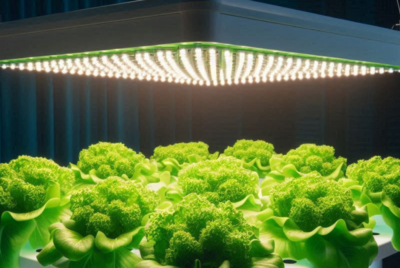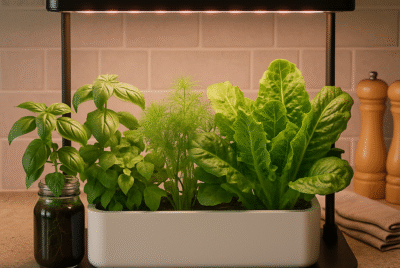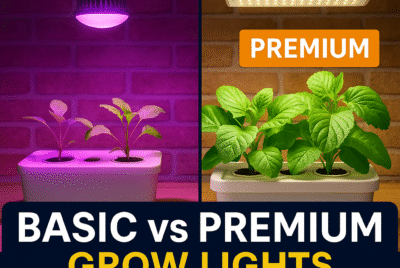Vertical Hydroponic Garden: Unlocking the Benefits
Imagine having a lush garden that thrives in limited space, where you can grow a variety of fresh vegetables, herbs, or even flowers. Vertical hydroponic gardening makes this dream a reality. The future is here, so let’s dive into the captivating benefits it offers.
What is a vertical hydroponic garden?
A vertical hydroponic garden is a system that allows plants to be grown vertically, utilizing available vertical space. With continued urbanization, there is a natural push to hydroponic gardening with improved research on indoor farming. “NASA has been working for decades to tackle food production both on Earth and in space. Feeding astronauts during long-term space exploration means stretching resources to grow plants in space including minimizing water use and energy consumption and eliminating soil”.
Benefits of vertical hydroponic gardening
Vertical hydroponic gardening has great advantages and definitely an appealing choice if you are are an experienced gardener or just a hobbyist.
Here are some key benefits:
Space & Water Efficiency
- Utilizing vertical space: Vertical gardens maximize space utilization by growing plants upward, making them perfect for small balconies, patios, or even indoor settings.
- Ideal for small spaces: With limited land or urban living, vertical hydroponic gardens offer a practical solution to grow your own fresh produce.
Increased Yield
- Maximizing plant density: Vertical gardening allows for higher plant density, enabling you to grow more plants in a given area. This leads to increased yield and greater harvests.Harvesting more in less space: By utilizing vertical space, you can grow a larger quantity of plants, resulting in a bountiful harvest from a compact garden.
- Water Conservation
- Efficient water usage: Vertical hydroponic systems are designed to be water-efficient, as they recirculate and reuse water.
- Minimizing water waste: With precise irrigation and nutrient delivery systems, vertical gardens ensure that water is targeted directly to the roots of the plants, minimizing water wastage through evaporation or runoff.
Nutrient Efficiency
- Controlled nutrient delivery:
Hydroponic systems allow precise control over nutrient solutions, providing plants with the optimal balance of nutrients they need for healthy growth. This promotes efficient nutrient absorption and enhances plant development.
Pest and Disease Control
- Reduced risk of pests and diseases:
- Vertical hydroponic gardens are elevated and off the ground, making the garden less susceptible to pests and diseases that typically thrive in soil. This reduces the need for harmful pesticides and makes pest management more manageable.
- Easier monitoring and management:
- With plants arranged vertically, it becomes easier to inspect and monitor their health. Any signs of pests or diseases can be spotted early, allowing for prompt intervention and preventing widespread damage.
- Accessibility for individuals with physical limitations:
- The elevated nature of vertical gardens ensures anyone can access the garden
- Growing a variety of crops: Vertical hydroponic gardens offer versatility in crop selection.
- From leafy greens including Hydroponic Lettuce , Hydroponic Strawberries, Hydroponic Tomatoes and herbs to vine crops and even flowers, you can experiment with a diverse range of plants to suit your preferences and culinary needs.
- Flexibility in garden design:
- With vertical gardening, you have the freedom to design and customize your garden layout.
Environmental Benefits
- Reduced land and soil degradation: Vertical hydroponic gardening minimizes the need for soil, thereby reducing soil erosion and degradation. This sustainable approach protects valuable land resources and promotes environmental conservation.
- Lower carbon footprint: By growing plants closer to where they will be consumed, vertical gardens reduce the carbon emissions associated with transportation and distribution. This contributes to a more sustainable and eco-friendly food system.
Getting Started
Let’s explore the essential steps to get started on your own vertical garden.
- Choosing a suitable location: The first step is to identify a suitable location for your vertical hydroponic garden.
- Sunlight availability:Choose a spot that receives adequate sunlight for the specific plants you plan to grow. Most vegetables and herbs thrive with 6-8 hours of direct sunlight per day.
- Selecting the right system:Vertical hydroponic garden systems come in various designs and configurations.
- Size and capacity:Choose a system size that suits your available space and desired plant capacity for the space you have available.
- Ease of use:Look for systems that are user-friendly, with clear instructions and Step-by-step guidance for assembly and maintenance.
- Water and nutrient management:Consider systems that provide efficient water and nutrient circulation, with options for monitoring and adjusting nutrient levels.
- Material durability:Opt for systems made from high-quality materials that can withstand the environmental conditions and ensure the longevity of your vertical garden.
Setting Up the Garden
With your location chosen and the system selected, it’s time to set up your vertical hydroponic garden. Follow these steps:
- Assembling the vertical structure:
- Unpack and organize the components of your vertical garden system.
- Follow the manufacturer’s instructions to assemble the framework or structure according to the provided guidelines.
- Ensure that all connections are secure and stable to support the weight of the plants.
- Installing the hydroponic system:
- Install the irrigation system and nutrient delivery mechanism according to the system instructions.
- Connect the water supply and ensure proper water flow and distribution throughout the system. Test the system for leaks or malfunctions and make any necessary adjustments or repairs.
- Space requirements:
- Take into account the space available in your vertical system and choose plants that can thrive in compact environments.
- Growth cycle:
-
- Consider the growth cycle of the plants and whether they are compatible with your desired harvest schedule.
- Personal preferences:
- Grow plants that you enjoy eating or ones that contribute to the aesthetics of your garden.
- Providing Light and Nutrients:
- Light and nutrient management are vital for the health and productivity of your vertical hydroponic garden. Follow these guidelines:
- Proper lighting for vertical gardens
- Assess the natural light conditions in your chosen location and determine if supplemental grow lights are necessary.
- Choose LED grow lights that emit the appropriate light spectrum for plant growth, including blue and red wavelengths.
- Position the lights at the optimal height and angle to ensure uniform light distribution across all plants.
Nutrient solution management
- Select a suitable hydroponic nutrient solution based on the specific needs of your chosen plants.
- Follow the manufacturer’s instructions to prepare and mix the nutrient solution with water.
- Monitor the pH and nutrient levels regularly using a pH meter and a nutrient testing kit.
- Make adjustments as necessary to maintain the optimal nutrient balance for healthy plant growth.
Monitoring
To keep your vertical hydroponic garden thriving, regular maintenance and care are essential.
Follow these tips:
Regular monitoring and adjustments
- Check the water levels in the reservoir and ensure proper water circulation throughout the system.
- Monitor the pH and nutrient levels regularly and adjust them as needed to maintain optimal conditions for plant growth.
- Inspect the plants for any signs of pests, diseases, or nutrient deficiencies. Take immediate action to address any issues.
Preventing common issues
Maintain cleanliness by periodically cleaning the system components to prevent algae growth and clogs.
Closing remarks
Remember, a vertical hydroponic garden offers an innovative and efficient way to grow plants vertically, utilizing limited space effectively.
By actively planning and addressing the specific needs of your chosen plants, you can create a thriving and visually stunning garden that yields a plentiful harvest.
FAQs
1. What does a vertical hydroponic garden entail?
A vertical hydroponic garden involves creating a space-efficient system that grows plants vertically, using stacked layers or vertical towers. It maximizes growing space and allows for cultivation in limited areas.
2. What are the benefits of using a vertical hydroponic garden?
Using a vertical hydroponic garden offers advantages such as increasing yield in a smaller footprint, optimizing space utilization, reducing water consumption, simplifying maintenance and harvesting, and enabling the growth of various plants in an organized and visually appealing way.
3. Which plants can I grow in a vertical hydroponic garden?
A vertical hydroponic garden accommodates a wide range of plants, including leafy greens, herbs, strawberries, vine crops like tomatoes and cucumbers, and even certain flowering plants. It allows for a diverse and productive garden.
4. How does a vertical hydroponic garden function?
In a vertical hydroponic garden, nutrient-rich water is actively pumped to the top of the system and flows down through each layer, nourishing the plants’ roots. The water is then collected and recirculated, ensuring a continuous supply of nutrients.
5. What should I consider when setting up a vertical hydroponic garden?
When setting up a vertical hydroponic garden, it’s crucial to consider factors such as proper lighting, adequate spacing between plant layers, the choice of growing medium, managing the nutrient solution, monitoring pH and EC levels, and ensuring proper ventilation and airflow to promote healthy plant growth.
*We may earn a commission from purchases made through our links, at no cost to you. This does not affect our product recommendations. Please see our disclosure to learn more.




